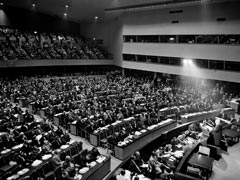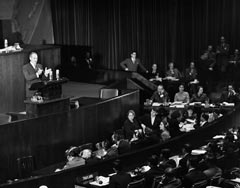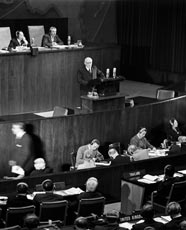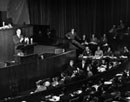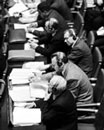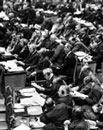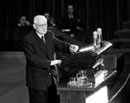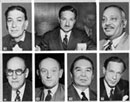|
Uniting for Peace
General Assembly resolution 377 (V) New York, 3 November 1950
By Christian Tomuschat
Professor emeritus at Humboldt University, Berlin
On 3 November 1950, the General Assembly adopted resolution 377 A (V), which was given the title “Uniting for Peace”. The adoption of this resolution came as a response to the strategy of the Union of Soviet Socialist Republics (USSR) to block any determination by the Security Council on measures to be taken in order to protect the Republic of Korea against the aggression launched against it by military forces from North Korea. The most important part of resolution 377 A (V) is section A which states that where the Security Council, because of lack of unanimity of the permanent members, fails to exercise its primary responsibility for the maintenance of international peace and security, the General Assembly shall seize itself of the matter. Procedural and substantive steps are suggested. First of all, if the Assembly is not in session, it may meet in emergency special session at the request of the Security Council or of a majority of its own members. Second, such a session shall be convened with a view to making appropriate recommendations for “collective measures…including the use of armed force when necessary”. As also the language of the resolution clearly reveals, the General Assembly can never be a full substitute for the Security Council in this area. Accordingly, only “recommendations” are mentioned, i.e., pronouncements devoid of any binding legal force. Additionally, resolution 377 A (V) establishes two auxiliary bodies, a Peace Observation Commission, which existed until 1960, and a Collective Measures Committee, which had a short life of only two years. None of these bodies has played any role of major significance. Although the General Assembly did not attempt to arrogate to itself powers akin to those rooted in Chapter VII of the Charter, it stands to reason that originally resolution 377 A (V) was hardly reconcilable with the Charter. Articles 11 and 12 establish unequivocally the primacy of the Security Council with regard to all matters relating to international peace and security. As far as procedure is concerned, Article 12, paragraph 1, stipulates that while the Council is exercising its function in respect of any dispute or situation, “the General Assembly shall not make any recommendation with regard to that dispute or situation”. On the other hand, where “action” seems to be necessary, the General Assembly is enjoined to refer the matter to the Council (Article 11, paragraph 2). This configuration, however, was hard to uphold. Politically, it is definitely quite unwise to keep the General Assembly on the sidelines when a major conflict erupts. Almost as a logical consequence, Article 11, paragraph 2, and Article 12, paragraph 1, have suffered an erosion process of which resolution 377 A (V) constitutes only one element among many others. In its Advisory Opinion on the Legal Consequences of the Construction of a Wall in the Occupied Palestinian Territory, the ICJ has formally confirmed that the prohibition of simultaneous action has been superseded by practice (I.C.J. Reports 2004, p. 136, at paras. 27-28). To date, ten emergency special sessions have been convened. The first one took place on the occasion of the 1956 war between Israel and Egypt and the British-French attack on the Suez Canal zone; the tenth emergency special session, dealing with the Israeli occupation of Palestinian territory, started in 1997 and has not yet come to its end. (It was adjourned by resolution ES-10/16 of 17 November 2006, para. 13, and can at any time be resumed upon request by Member States.) According to political criteria, different patterns can be distinguished. If the Security Council is unanimous in requesting such a session, the harmony between the two main organs of the United Nations is not disturbed. The crisis in Lebanon prompted the Security Council in 1958 to convene an emergency special session of the General Assembly (resolution 129 (1958) of 7 August 1958). It did so without mentioning explicitly resolution 377 A (V), and one may indeed have doubts as to whether this was a case of application of that resolution since there was no lack of unanimity of the permanent members. The situation in Lebanon was referred to the General Assembly because the Security Council had no solution to offer. The second situation is characterized by a vote of a majority of the members of the Security Council against the opposition of some other members, including permanent members. In such instances, the veto does not operate since referral to the General Assembly is considered to constitute a procedural determination and hence not subject to such blocking power. Understandably, the first emergency special session was called by the Security Council against the resistance of France and the United Kingdom (resolution 119 (1956) of 31 October 1956). In the Hungarian crisis, which unfolded almost at the same time, the roles were distributed differently, with only the USSR opposing the motion (resolution 120 (1956) of 4 November 1956). Similar configurations could be observed with regard to the holding of emergency special sessions on the Republic of the Congo (resolution 157 (1960) of 17 September 1960: opposition of Poland and the USSR), on the conflict between India and Pakistan on account of East Pakistan/Bangladesh (resolution 303 (1971) of 6 December 1971: abstention of France, Poland, the USSR and the United Kingdom), and on Afghanistan (resolution 462 (1980) of 9 January 1980: opposition of the German Democratic Republic and the USSR). Total emancipation from the Security Council is reached where the Secretary-General convenes an emergency special meeting at the request of a United Nations Member acting with the support of a majority in the General Assembly. The seventh emergency special session on Palestine (1980-1982) was in fact initiated by Senegal, the eighth emergency special session on Namibia (1981) goes back to a request by Zimbabwe, and the tenth emergency special session was solicited by Qatar as the Chair of the Group of Arab States at the United Nations. It stands to reason that in such instances the overwhelming weight of third world countries can manifest itself to its full extent. Urgent matters may also be dealt with during the ordinary sessions of the General Assembly if the Security Council takes no action owing to the negative vote of a permanent member. (A prominent example is provided by General Assembly resolution 41/38 of 20 November 1986, dealing with the aerial and naval attack on Libya by the United States.) Although the shifting of responsibilities to the General Assembly may not be consistent with the original intentions of the drafters of the Charter, it is today fully accepted that emergency special sessions have become an integral part of the legal order of the United Nations. On the other hand, the need for the holding of such sessions has considerably decreased, as for many years the General Assembly is frequently in session much beyond the usual period from September to December. On a regular basis sessions are resumed in plenary meetings for short periods in the months before the start of a new session in September. In the early years, Member States were not represented in New York throughout the year. Today, urgent matters can be dealt with by the General Assembly at short notice. As already pointed out, the tenth emergency special session, which started in 1997, has not yet been concluded and has for many years operated alongside the regular sessions of the General Assembly. (In its Advisory Opinion on the Wall case (I.C.J. Reports 2004, p. 152, at para. 34), the ICJ did not raise any objections against that practice.) It has become a special forum to deliberate on the policies and practices of Israel with regard to the occupied Palestinian territories, totally changing its character from a meeting convened to discuss urgent matters to a permanent, but intermittent conference on a topic of paramount interest to the international community. Obviously, the crucial element of resolution 377 A (V) was the affirmation that the General Assembly may, if deemed appropriate by it, recommend collective action, including the use of force. In this core sense, the resolution has been implemented only once in the Korean crisis. By resolution 498 (V) of 1 February 1951 it made a finding to the effect that the People’s Republic of China had engaged in aggression in Korea (para. 1) and “call[ed] upon all States and authorities to continue to lend every assistance to the United Nations action in Korea” (para. 4), which of course meant military assistance. The resolution does not explicitly refer to the Uniting for Peace resolution, but it emphasizes that the Security Council, “because of lack of unanimity of the permanent members, has failed to exercise its primary responsibility for the maintenance of international peace and security” (preamble). Thus, the wording is exactly copied from resolution 377 A (V). The establishment of the peacekeeping operation First United Nations Emergency Force (UNEF I) by resolution 1000 (ES-I) of 5 November 1956 with a view to monitoring the frontline between Israel and Egypt does not come within the same category since UNEF I had no combat function to discharge but was meant to neutralize the conflict solely by its presence between the two opposing parties in accordance with the “classic” peacekeeping concept which was given birth on that occasion. On the whole, it is not easy to draw the demarcation line between “measures” contemplated specifically by resolution 377 A (V) and other measures which the General Assembly may recommend within the framework of its general mandate without any hindrance. According to the Advisory Opinion of the ICJ in the Certain Expenses case, the exclusive powers of the Security Council are confined to coercive or enforcement action (Certain Expenses of the United Nations (Article 17, paragraph 2, of the Charter), Advisory Opinion of 20 July 1962, I.C.J. Reports 1962, p. 151, at 164), but the ICJ did not discuss specifically the impact of resolution 377 A (V). In this connection, the question arises, inter alia, how the imposition of an embargo, as formerly practiced by the General Assembly in a sustained fashion to the detriment of South Africa, is to be characterized (this practice commenced with resolution 41/35 F of 10 November 1986). In any event, it has become a regular feature of resolutions of the General Assembly with regard to armed conflicts to call upon the parties to desist from any hostilities and to withdraw their troops to their own territories (see, for instance, resolution 62/243 of 14 March 2008, on the situation in the occupied territories of Azerbaijan). Such requests are not considered as requiring any particular legitimation under resolution 377 A (V). Resolution 377 A (V) has a potential that could subvert the well-equilibrated balance of power within the United Nations, a potential that is not disclosed in a recent description of the role and authority of the General Assembly (see resolution 60/286 of 8 September 2006, annex, para. 1). But it would actually be used against the Security Council only in case of general dissatisfaction with the policies of the permanent members. Notwithstanding their sheer numerical superiority, the many Members of the United Nations are much too weak to attempt to challenge the decisions made at the Security Council. Any application of Uniting for Peace with a view to taking enforcement action would at least need the support of one of the permanent members. To date, resolution 498 (V) of 1951 remains the only example of a situation where the General Assembly, at that time under dominating Western influence, recommended taking such action, notwithstanding the firm resistance of a permanent member. This Introductory Note was written in October 2008.
Related Materials
The item “Uniting Action for Peace” was included in the agenda of the fifth session of the General Assembly at the request of the United States and was considered by the First Committee of the General Assembly from 9 to 21 October 1950.
The joint seven-Power draft resolution and the USSR draft resolutions formed the basis of the general discussion in the First Committee. The Iraqi-Syrian draft resolution was discussed separately. On 14 October 1950, the Committee voted by roll call on the revised joint seven-Power draft resolution (A/C.1/576/Rev.1) which was adopted by 50 votes to 5, with 3 abstentions. The Committee next considered the two USSR draft resolutions: draft resolution A/C.1/579, as amended by France and Uruguay, was adopted by 49 votes to none, with 9 abstentions; draft resolution A/C.1/580 was rejected by 34 votes to 6, with 18 abstentions. Finally, the revised draft resolution of Iraq and Syria (A/C.1/585/Rev.2) was put to the vote and adopted unanimously by the Committee.
On 3 November 1950, the General Assembly put to vote the USSR amendments, the resolutions recommended by the First Committee and the USSR draft resolution. None of the USSR amendments were adopted. The draft resolutions recommended by the First Committee were adopted separately (resolution 377 A (V), adopted by roll-call vote of 52 to 5, with 2 abstentions; resolution 377 B (V), adopted by 57 votes to 0, with 6 abstentions; and resolution 377 C (V), adopted by vote of 57 votes to 0). Resolution 377 (V) (Uniting for Peace) was then adopted as a whole, on the same day, by 52 votes to 5, with 2 abstentions. Text of the Resolution Selected preparatory documents Draft resolution submitted by Chile (A/C.1/575, 5 October 1950)
|
||||||||||||||||||||||||||||||||||||||||||||||||||||||||||||||||||||||||||||||||||||||||||||||||||||||||||||||||||||||||||||||||||||||||||||||||||||||||||

